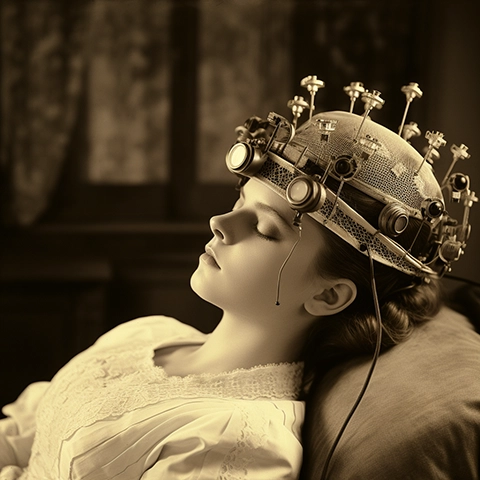In the late 19th century, as the Industrial Revolution swept across the Western world, the desire for innovation and progress was at an all-time high. The late 1800s were a period marked by incredible technological advancements and a spirit of unbridled enthusiasm for scientific discovery. In this era of endless possibilities, a peculiar invention emerged, promising to revolutionize the way people experienced sleep. It was called the Brainwave Sleep Enhancer, and it was hailed as a marvel of modern science.
The Brainwave Sleep Enhancer, patented in 1882 by a mysterious inventor who went by the name “Dr. Victor L. Somnambul,” claimed to be a revolutionary device worn on the head. According to advertisements of the time, this machine was designed to monitor brainwaves and deliver customized music, guaranteeing the perfect, rejuvenating night’s sleep. In an age when sleep disorders were not well understood, this invention seemed like a godsend to those suffering from restless nights.
At first glance, the Brainwave Sleep Enhancer appeared to be an impressive piece of technology. Its design was elegant and appeared to be based on sound scientific principles. Dr. Somnambul was hailed as a visionary who sought to unlock the secrets of the human mind, promising to lead his users into the realm of undisturbed, profound sleep.
The Brainwave Sleep Enhancer claimed to operate by analyzing the user’s brainwave patterns and adjusting the music it played accordingly. It promised to soothe and relax the wearer with a selection of calming melodies that would adapt in real-time to the user’s unique mental state. On the surface, it was a tantalizing prospect, given the prevalence of sleep-related disorders and insomnia during the era.
The machine soon gained a loyal following, and individuals across the nation eagerly purchased the Brainwave Sleep Enhancer in hopes of achieving the perfect night’s sleep. Some even claimed to experience a more restful slumber, and the word of its effectiveness spread like wildfire.
However, as time passed, troubling rumors began to circulate about Dr. Victor L. Somnambul and his Brainwave Sleep Enhancer. Skeptics questioned the authenticity of the inventor, who was known for being reclusive and never appearing in public to showcase his creation. Doubts were also raised about the device’s actual ability to monitor brainwaves and adjust music accordingly. But the most shocking revelation was yet to come.
In 1885, an intrepid journalist named Amelia Thornton embarked on an investigative journey to uncover the truth behind the Brainwave Sleep Enhancer. Her relentless pursuit of the facts ultimately led to the shocking discovery that would shatter the device’s reputation.
Amelia Thornton, with the help of experts in various fields, unveiled the dark secret concealed within the Brainwave Sleep Enhancer. The machine contained a hidden chamber filled with a slow-release mechanism for chloroform. While the wearer believed they were drifting into a natural slumber, they were, in fact, being subtly and dangerously sedated by the chloroform vapor.
Dr. Victor L. Somnambul, it turned out, was no visionary scientist but rather a clever charlatan preying on the vulnerability of those seeking a better night’s sleep. The Brainwave Sleep Enhancer, which had seemed so promising, was nothing more than a dangerous deception. Many of those who had used the device were shocked and angered by the revelation, feeling betrayed by a huckster who had exploited their desire for better rest.
The scandal surrounding the Brainwave Sleep Enhancer served as a cautionary tale about the dangers of trusting too readily in technological marvels, especially in a time of scientific innovation. As the truth came to light, the device’s reputation crumbled, and Dr. Victor L. Somnambul disappeared from public view, leaving behind a trail of shattered dreams and disillusioned customers.
The Brainwave Sleep Enhancer of 1882 stands as a stark reminder of the capacity for deceit in even the most innovative and seemingly promising inventions. It serves as a testament to the importance of skepticism and critical inquiry in the face of scientific claims, even in a time of great technological change.

